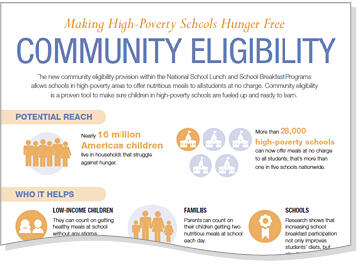off the charts
POLICY INSIGHT
BEYOND THE NUMBERS
BEYOND THE NUMBERS
Community Eligibility: Spreading the Word About an Important Hunger-Fighting Tool
Receive the latest news and reports from the Center
Community eligibility, a provision of the Healthy, Hunger-Free Kids Act of 2010, will allow more than 28,000 schools in high-poverty neighborhoods to offer nutritious meals to all students at no charge next year, as we’ve explained. Schools must opt in to take advantage of this important anti-hunger initiative — which underscores the need to spread the word about its success so far.
Community eligibility has been phased in over the last three years. About 4,000 schools in 600 school districts in low-income communities across 11 states already offer community eligibility, and it has led to a striking increase in the number of children in high-poverty areas eating school breakfast and lunch. In schools in Illinois, Kentucky, and Michigan that have used the option for two years, lunch participation rose by 13 percent and breakfast participation rose by 25 percent, with 29,000 more low-income children eating breakfast daily.
Beginning with the 2014-2015 school year, high-poverty schools and school districts in all states will be eligible to adopt community eligibility to help reduce hunger and make school meal programs more efficient. Schools have until August 31 to opt in, thanks to a deadline extension from the Agriculture Department.
That means schools will get more time to consider adopting community eligibility — and to learn more about its many benefits, as we detail in a new infographic.

Meeting children’s nutritional needs prepares them to grow, learn, and thrive in the classroom. Ensuring that all children get a healthy breakfast and lunch is certainly a goal of parents, but teachers, schools, and neighborhoods benefit too when children get the food they need to succeed.
Click here for more information about community eligibility.